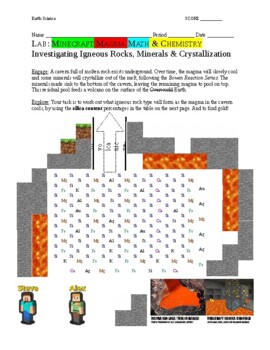Minecraft Magma Math and Chemistry Investigation in Igneous Rock
- Word Document File
Description
Use the setting of the video game Minecraft to explore Earth Science. Student are engaged by imagining a cavern full of molten rock exists underground. When the magma cools off, what igneous rock types will be formed over time? And for extra credit find out how much gold ore will exist, and if it's worth risking the monsters for the mining! Students solve this real-world math problem with paper and pencil by using the silica content percentage, as minerals will crystallize out of the melt.
Students will make connections between this science skill and the hit game that is enjoyed by many, especially in their age range. Minecraft includes types of igneous rock so this is a great real-world activity since the video game has provided them the background knowledge. This printable is not licensed by Microsoft or Minecraft.
This activity is classroom tested to help students with the following Florida Next Generation Sunshine State Standards in Science:
- SC.7.E.6.2 Identify the patterns within the rock cycle and relate them to surface events (weathering and erosion) and sub-surface events (plate tectonics and mountain building).
- SC.912.E.6.2 Connect surface features to surface processes that are responsible for their formation
Related Products
- Question Exploration: What is the Rock Cycle? Igneous, Sedimentary, Metamorphic
- Concept Compare Frame: Igneous Rocks (Intrusive, Extrusive and Tephra)
- Question Exploration: How are Sedimentary Rocks Classified?
- Edible Rock Cycle with Candy Lab
- Logic LineUp: Rock Cycle Puzzle (Igneous, Sedimentary, Metamorphic and Magma)
- Minecraft Magma Math and Chemistry Investigation in Igneous Rock
#StayGiant and stay up on my new resources and STEM news. Look for the green ★ star near the top of any page within my store and click "FOLLOW". Or follow @TheScienceGiant on Twitter. Stand on The Shoulders of Giants, and together we'll see further, inspire students, and enlighten inquisitive minds!





